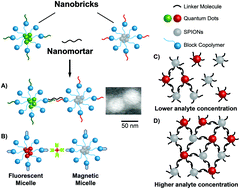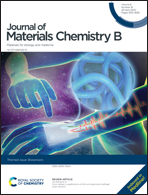Biomolecular detection, tracking, and manipulation using a magnetic nanoparticle-quantum dot platform†
Abstract
Fluorescent and magnetic materials play a significant role in biosensor technology, enabling sensitive quantification and separations with applications in diagnostics, purification, quality control, and therapeutics. Here, we present a magneto–fluorescent biosensor/separations platform consisting of quantum dots (QDs) and superparamagnetic iron oxide nanoparticles (SPIONs) that are separately encapsulated in amphiphilic block co-polymer micelles conjugated to DNA or protein (i.e., single-stranded (ss) DNA derived from the mRNA of the tumor suppressor protein p53 or avidin protein). Analytes were detected via an aggregation sandwich assay upon binding of at least 1 QD and 1 SPION-containing micelle to result in a fluorescent/magnetic composite. Multiplexed isolation of protein and DNA biomolecules was demonstrated by using QDs of varying emission wavelength; QD fluorescence intensity could be correlated with analyte concentration. Sequential or parallel biomolecule separation was achieved by adding appropriately functionalized SPION-containing micelles and applying user-controlled magnetic fields via patterned magnetic disks and wires. QD fluorescence was used to continuously visualize analyte separation during this process. This QD/SPION platform is simple to use, demonstrates ∼10−16 M sensitivity in analyte detection (comparable to competing QD biosensors based on energy transfer) with specificity against 1 and 2 basepair mismatches in DNA detection, molecular separations capability in solutions of ∼10−10 M, and permits simultaneous or parallel, multiplexed separation of protein and DNA. Thus, this versatile platform enables self-assembly-based rapid, sensitive, and specific detection and separation of biomolecules, simultaneously and with real-time visualization. This technology demonstrates potential for nanoscale assembly, biosensing, and bioseparations.

- This article is part of the themed collection: Biosensors


 Please wait while we load your content...
Please wait while we load your content...